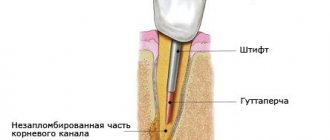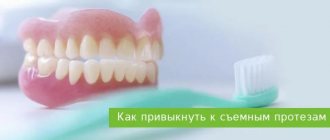Publication date: December 26, 2022.
Date the information on this page was updated: December 07, 2021.
Before installing braces, it is difficult to imagine the sensations in your mouth after installing an unusual structure made of ceramic or metal. Some people even put off orthodontic treatment due to fear of pain. In this article we will try to explain what sensations arise when installing, wearing and removing braces, why they occur and how to reduce discomfort.
Why does pain occur when wearing braces?
To begin with, let's figure out how the dental system works and how braces work. Teeth grow from the alveolar process, a bone formation in the jaw. The roots of the teeth are fixed in the bone tissue by a ligamentous apparatus - periodontium.
Due to the traction of the arc, braces move not only the part of the teeth that is visible to us - the crown, but also the roots of the teeth. Under the influence of braces, the ligaments, which contain many nerve endings, gradually stretch and the tooth moves along the bone tissue.
It is the processes of movement of the roots of teeth that cause sensations of varying degrees of intensity in people, depending on the individual pain threshold. Some people feel quite severe pain, some only have unpleasant feelings when biting food, others experience itching and mobility of teeth.
What does it feel like while wearing braces?
- Aching pain, especially aggravated when biting food and chewing.
- Chafing of cheeks, lips and tongue from clasps, orthodontic hooks and wires. During the first time after installation, the mucous membrane gets used to the structure in the mouth, the tongue and lips tend to take their usual position, but encounter braces. Sometimes it is impossible to close your lips or articulate clearly. Over time, the mouth and lips adapt to braces and the pain goes away. Getting used to with lingual braces takes longer than with classic braces, since they are located on the inside of the teeth and greatly interfere with the tongue.
- Feeling of tooth mobility and “soft” teeth. It seems that the tooth is loose or, when biting and pressing, “sinks” into the gum. In fact, the teeth are mobile, but not so much that they fall out or suddenly change position.
- Itching in the teeth and gums. Some patients' teeth do not hurt, but itch and itch. This, like aching pain, is the result of irritation of nerve endings during the gradual restructuring of periodontal and bone tissue. If you experience such sensations, you should never try to mechanically scratch your gums (with a toothpick, hard brush, etc.) - you can seriously injure yourself.
When does discomfort or pain occur during orthodontic treatment?
When wearing braces, your teeth do not constantly hurt: soon after installation, the oral cavity adapts to the structure, and the braces act on the ligaments gradually and gently. The sensations from braces are especially strong during the installation and activation stages, when the teeth are not yet accustomed to the pressure and new position.
Feeling when installing braces
The process of installing braces consists of three stages: preparing the teeth, gluing with a lock and installing the arch. The first 3 stages are absolutely painless - with healthy enamel (and this is a prerequisite for installing braces), applying the adhesive, drying and etching the tooth does not cause any discomfort. But when fixing the arch, a feeling of tightness and “heaviness” of the teeth appears. It is from this moment that braces begin to work - the arch, fixed in the grooves of braces on uneven teeth, strives to take its original “correct” position and pulls the teeth along with it.
In the first 1-3 weeks, unusual pressure is placed on the teeth, and the patient may experience quite severe pain. During this period, it is difficult to chew even soft foods, because with any pressure on the teeth, the pain worsens significantly, and a feeling of mobility appears.
During this period, in addition to pain in the area of the roots of the teeth and the alveolar process, the cheeks, lips and tongue may hurt due to unusual contact with braces.
Feelings when wearing braces
After adaptation to braces, severe pain goes away, and the design becomes familiar - most of the time, patients do not notice the presence of braces and live a normal life.
Discomfort returns with periodic activation of braces - on average once every 3 months. At appointments, the orthodontist can replace the archwire with a more rigid one, make bends in the archwire, re-glue the clasps, install a chain, or fix hooks for elastics.
Elastic traction for braces
After each small change, braces begin to work in a new way - pulling the teeth a little harder, or at a slightly different angle. The teeth begin to realign again and the patient may experience pain or discomfort. New hooks for elastics can injure the mucous membrane at first.
If the orthodontist has prescribed the wearing of rubber bands - elastics, then they can become a source of unusual sensations in the mouth: they pull and put pressure on individual teeth. Sometimes the sensation spreads to the entire jaw: it feels heavy and tense.
Feelings when removing braces
Even if after two years of wearing braces it seems that the braces have become one with the teeth and it will be painful to remove them, do not be afraid. In fact, removing braces is safe and painless due to the removal technology and special tools.
The bracket is grabbed with special pliers, which are securely fixed on the sides of the lock and do not slip off. The orthodontist squeezes the forceps, under pressure the bracket is slightly deformed, and its base easily peels off from the tooth. Next, the teeth are cleaned of the adhesive and polished.
Removing braces
The entire removal process takes up to 30 minutes and does not injure the teeth, gums or mucous membranes. Sometimes you can only feel a slight pressure when peeling off the locks.
Types of braces systems and their installation
Depending on the degree of complexity of correcting existing defects and the planned time for the patient to wear braces, the doctor suggests two main types of their design:
- Removable bracket system
It is recommended to remove it before eating and while brushing your teeth.
- Fixed system
The system is not removed for the entire duration of treatment. While wearing it, the doctor regularly makes certain adjustments.
None of the patients complained that their teeth hurt from braces when they were installed. Although such a procedure can last 1.5-2.0 hours. The painlessness of the operation is explained by the fact that the design of the braces during installation comes into direct contact with the tooth enamel, which has no nerve endings and simply does not feel pain.
The above installation times are averages. The duration of the operation depends on the following:
- doctor's qualifications and practical experience.
- individual characteristics of the patient’s teeth and jaw.
Pain when wearing braces that is not normal
Above we described discomfort with braces, which is normal. But some painful sensations indicate inflammatory or pathological processes.
The fact is that orthodontic treatment is a serious test for the body. The entire dental system is being rebuilt and requires special monitoring and care.
What sensations may indicate the presence of dental diseases:
- Aching and sharp pain in individual teeth
can be caused by caries or inflammation of the canals. - Pain in the area of contact between the gums and teeth
as a result of recession - loss of gums. Recession often accompanies orthodontic treatment, as the roots of the teeth move and put pressure on the periodontal tissue, which can cause gradual gum resorption. - Pain in the temporomandibular joint.
Some patients are predisposed to TMJ dysfunction - the joint can move into a new position during orthodontic treatment and cause discomfort and discomfort. You must report them to the orthodontist - the doctor will take the necessary measures. - Enamel sensitivity
. Braces make hygiene difficult and can weaken tooth enamel. If the enamel is excessively sensitive, you should definitely visit a therapist or hygienist. A specialist will clean and remineralize your teeth.
To prevent the development of inflammation, undergo professional hygiene and a preventive examination with a therapist at least once every six months. Report any strange or sharp sensations in your teeth, gums and joints to your orthodontist.
How long to wear braces?
What determines the duration of wearing braces
Duration of treatment with braces in children
How long does it take to install braces?
How long does it take to get used to braces?
How long does the retention period last?
Correcting the bite and straightening the teeth is a rather lengthy process, which for many is a stumbling block to orthodontic treatment. How long you need to wear braces is a question to which even orthodontists do not know the exact answer, since each case is individual. Let's look at what factors influence the timing of wearing braces.
How to relieve pain when wearing braces?
Each patient experiences individual sensations from braces, but even severe pain can be reduced if you follow the recommendations of doctors.
At the stage of choosing braces:
- Choose self-ligating braces - they put less aggressive pressure on the teeth than ligature ones. In self-ligating braces, the arch slides freely in the groove, and the force is distributed evenly.
- If you need faster and easier adaptation to braces, choose external or vestibular braces - they do not injure the tongue and do not spoil diction.
After installation and activation:
- Use orthodontic wax to smooth out protruding elements that rub the mucous membrane.
- Doesn't eat solid food. In the first 3 weeks after installing braces, it is recommended to eat only soft or pureed foods: purees, soups, etc.
- Rinse your mouth with anti-inflammatory agents (saline solution, chamomile decoction) so that inflammation does not occur at the site of the wounds from braces.
- Use healing gels to treat mucous membranes.
- Eat ice cream or drink cool water - cold foods reduce sensitivity.
Sensitivity while wearing braces varies from person to person. It is possible that orthodontic treatment will be completely free of pain and discomfort. But even painful sensations are not constant and are easily neutralized. And the excellent result after braces compensates for all the inconveniences.
How to reduce discomfort from wearing braces?
There are many techniques that can reduce pain from the pressure of the orthodontic structure on the teeth. It is possible that your doctor will tell you about them at your appointment, but if not, you can use our list of recommendations.
Food selection:
- From the first day of wearing the system, it is recommended to switch to food with a soft consistency, then you can gradually expand your diet, focusing on the sensations in your mouth;
- cold food causes less discomfort than warm or hot food;
- sour and spicy foods cause increased pain;
- Solid foods such as seeds and whole nuts are prohibited during the entire treatment period.
Changing habitual behavior:
- in the first 10-14 days it is recommended to make as little movements as possible with facial muscles: smile less, talk less;
- During the entire treatment, it is better not to sleep with your face buried in a pillow, as this increases the pressure of the system on the teeth and reduces the life of the structure.
Hygienic care:
- To brush your teeth, it is advisable to use a toothbrush with soft bristles and a small head;
- the retail chain has special toothpastes for braces;
- After each meal, you must rinse your mouth with a special mouthwash.
Medications help reduce discomfort:
- Non-steroidal anti-inflammatory drugs. Painkillers cannot be taken all the time, but in the first few days you cannot do without them. There are no special recommendations here. Any medications that the patient took for headaches before installing braces will be effective.
- Local anesthetics. A much safer group of drugs compared to painkillers in tablets, but practically unknown to a wide range of users. Examples include Colgate Orabase or Orajel. They are used topically, applied to the gums after rinsing the mouth.
The most difficult times when wearing braces are the first two weeks, the period of adaptation to the pressure of the orthodontic structure on the teeth. It should be easier further. If time passes and the level of discomfort does not decrease, you should notify your doctor. Perhaps something is going wrong and willful efforts to ignore the problem will only be harmful.
What a patient may encounter after having braces installed
Installation of the system is not accompanied by discomfort because tissue is not damaged. Getting braces is not difficult, but a person faces a number of problems:
- Sensation of teeth being squeezed. Present in the first days after gluing the locks. Bridges tighten the bone structure, which causes an unpleasant feeling. Gradually a person gets used to the action of braces. The pressure is felt again only when changing axles.
- Discomfort of the mucous membrane on the inner surface of the cheeks. The design creates friction with soft tissues, scratches and injures them. The result is burning, discomfort, and pain.
- Sharp pain from braces when pressing on a tooth. The latter experiences additional load in 2 cases: supercontact during chewing and displacement under the action of a spring. As a result, the enamel and dentin experience pressure, which is transmitted to the nerves contained within the bone, and acute pain occurs.
- A burning sensation on the gums. It may take several weeks or months to appear. When teeth are displaced under the action of a tightening structure, the tissues are subject to deformation. During the correction process, the gums receive microtraumas, which causes a burning sensation.
- Aching or dull pain radiating throughout the jaw. In most cases it appears within 24 hours after installing the system, sometimes it lasts a week. Pain syndrome can be caused by the severity of braces.
Possible causes of tooth pain after fixation and activation of the braces system
- Method of attaching the orthodontic arch to braces: ligature or non-ligature.
Ligatures are special rubber bands and metal wire that rigidly fix the arch. Due to the friction force, an additional load appears. Ligature braces often cause discomfort, and getting used to them takes longer. In non-ligature systems, the arch is fixed in special grooves of the braces - a more mobile mechanism is obtained, and the movement of teeth is softer and more comfortable. But it is impossible to guarantee the absence of unpleasant sensations when wearing braces without ligatures; they also require adaptation. - Orthodontist mistakes:
the doctor may set an incorrect trajectory for the movement of teeth. In this case, it will not only be painful, but the result of treatment will ultimately not be what the patient expects. If this mistake is not corrected in time, the pain can be really severe. This is the most serious orthodontic mistake. Therefore, you should not endure in silence, if you are in a lot of pain, you should definitely tell your doctor about it. Another mistake is “tightening” the braces, creating excessive pressure on the teeth. This is not as dangerous as an error in choosing the trajectory of movement, but is often no less uncomfortable for the patient. More often, this problem occurs with ligature brace systems that require frequent correction. - Pain threshold:
in patients with a low pain threshold, the entire jaw or part of the dentition may hurt. When choosing and installing braces, it is better to discuss this nuance with your orthodontist.
If the pain does not decrease in intensity within 14 days, be sure to consult a doctor. There is a high probability of errors when fixing braces.











